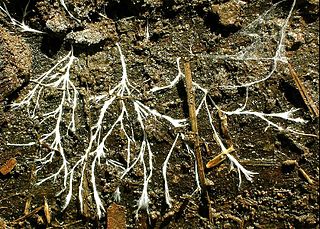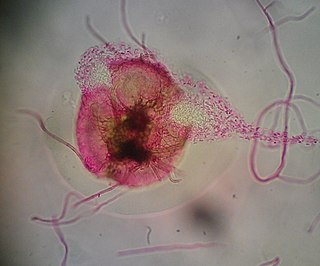
Mycelial cords are linear aggregations of parallel-oriented hyphae. The mature cords are composed of wide, empty vessel hyphae surrounded by narrower sheathing hyphae. Cords may look similar to plant roots, and also frequently have similar functions; hence they are also called rhizomorphs. As well as growing underground or on the surface of trees and other plants, some fungi make mycelial cords which hang in the air from vegetation.
Syspastospora parasitica is a mycoparasitic fungus. It attacks other fungi, particularly species of Beauveria and Isaria. It parasitizes the mycelium of its host by means of specialized contact cells, and produces dark brown, long-necked perithecia.

A pycnidium is an asexual fruiting body produced by mitosporic fungi, for instance in the order Sphaeropsidales or order Pleosporales. It is often spherical or inversely pearshaped (obpyriform) and its internal cavity is lined with conidiophores. When ripe, an opening generally appears at the top, through which the pycnidiospores escape.
Mycaureola is a genus of fungi in the family Physalacriaceae of mushrooms. Circumscribed in 1922 by French mycologists René Maire and Émile Chemin, the genus is monotypic, containing the single species Mycaureola dilseae. The fungus is a parasite of the red algal species Dilsea carnosa, on which it causes circular necrotic lesions.
The Lulworthiaceae are a family of marine fungi in the Ascomycota, class Sordariomycetes. Species in the family have a widespread distribution in both temperate and tropical oceans, and are typically found growing on submerged wood or on seaweed. In 2000, Molecular analysis of several species of Lulworthia and Lindra led to the reassignment of their parent genera to the new order Lulworthiales in addition to the new family Lulworthiaceae. In 2020, a large fungi study added more genera to the family.
Lulworthia is a genus of fungi within the Lulworthiaceae family.
Hubertus Antonius van der Aa was a Dutch mycologist who described several genera and species of fungi. He studied at Utrecht University where he received his PhD in 1973 with the dissertation Studies in phyllosticta I.
George Smith was a British mycologist. Born in Great Harwood, he graduated from the University of Manchester in 1916 with first-class honours, and received his Master's degree in chemistry two years later. After starting a laboratory with the textile manufacturing company Boardman and Baron Ltd. in 1919, he began to study the mildew and moulds that grew on goods made from cotton.
Roy Watling, PhD., DSc, FRSE, F.I.Biol., C.Biol., FLS is a Scottish mycologist who has made significant contributions to the study of fungi both in the identification of new species and correct taxonomic placement, as well as in fungal ecology.

Gulielma Lister was a British botanist and mycologist, and was considered an international authority on Mycetozoa.
Wardomyces is a genus of seven species of mould fungi in the family Microascaceae. The genus was circumscribed in 1923 by Frederick Tom Brooks and Clifford Gerald Hansford. The generic name honours Harry Marshall Ward, Professor of Botany at Cambridge University. The type species, Wardomyces anomalus, was originally found as a mould growing on rabbit meat kept in cold storage. The most recent addition to the genus is W. moseri, described by Walter Gams in 1995. Found in Colombia, it was discovered growing on a dead petiole of moriche palm.
Triangularia setosa is a member of the Ascomycota, and of the genus Triangularia. This genus is notable for its widespread appearance on the excrement of herbivores, and is therefore seen as a coprophilous fungus. The fungus itself is characteristically dark in colour and produces sac-like perithecium with a covering of hair. Its dispersion involves the ingestion, passage, and projectile ejection of spores. It has preference for colonizing the dung of lagomorphs, such as hares and rabbits.

Physodermatacae is a family of chytrid fungi in the order Physodermatales. Species in the family have a parasitic relationship with the host's physoderma. This family is distinctive in that it contains a thick wall around the sporangia to resist against unfavorable conditions. Sporangia releases from a host plant when rotting, dispersal is carried through the air. This family is not to be confused or related to basidiomycetes rusts and smut fungi. This parasite is distributed all across the world in aquatic, semi aquatic wetlands and in some ferns.
Kathleen Sampson was an English mycologist and plant pathologist, with a focus in herbage crops and cereal diseases. She was a leading authority on smut fungi growing in the British Isles.
Anders Munk was a Danish mycologist. He was an expert of the fungal group colloquially known as the Pyrenomycetes, and best known for his 1957 work "Danish Pyrenomycetes".
Colin Booth was an English mycologist, known a leading authority on the genus Fusarium.
Hyalochlorella marina, the only species in the genus Hyalochlorella and also known as Dermocystidium sp., is a marine heterotrophic eukaryote with uncertain phylogenic position.

The Eocronartiaceae are a family of fungi in the class Pucciniomycetes. Species in the family have auricularioid basidia and are typically plant parasites on ferns and mosses.

Tremella globispora is a species of fungus in the family Tremellaceae. It produces hyaline, pustular, gelatinous basidiocarps and is parasitic on pyrenomycetous fungi on dead herbaceous stems and wood. It was originally described from England.






